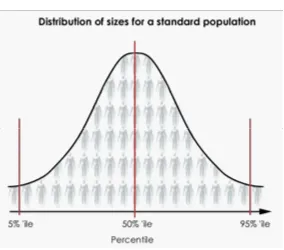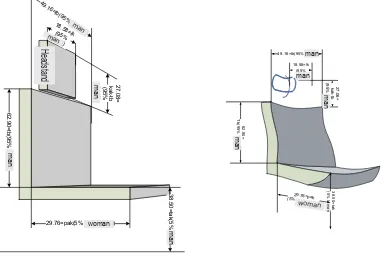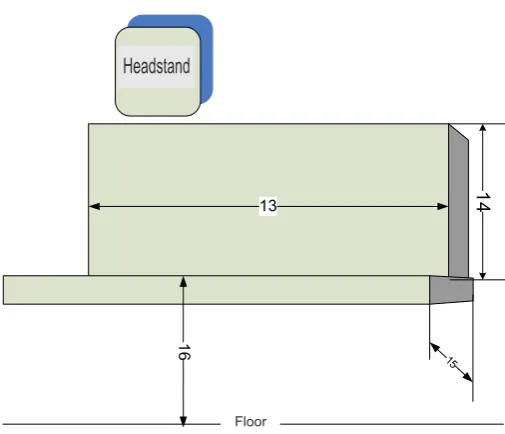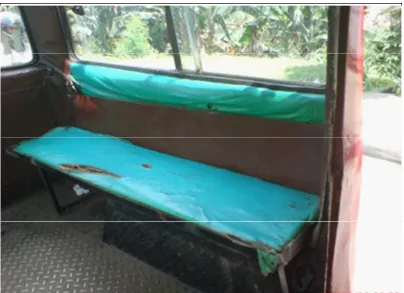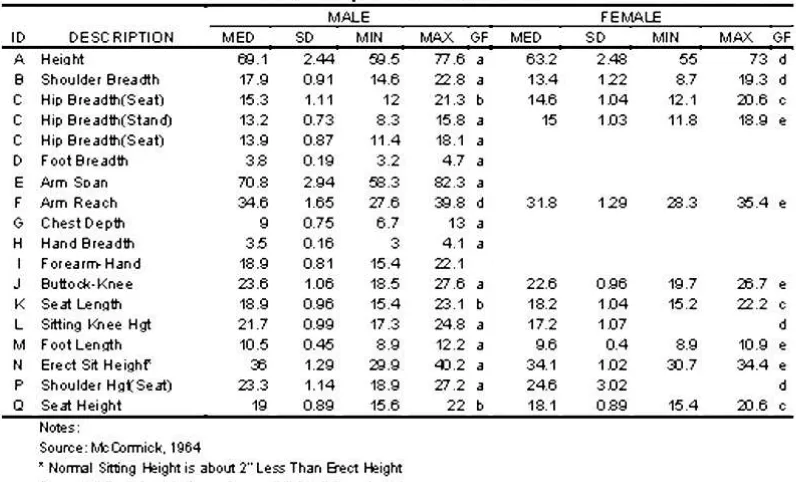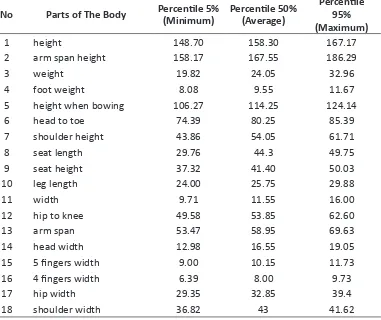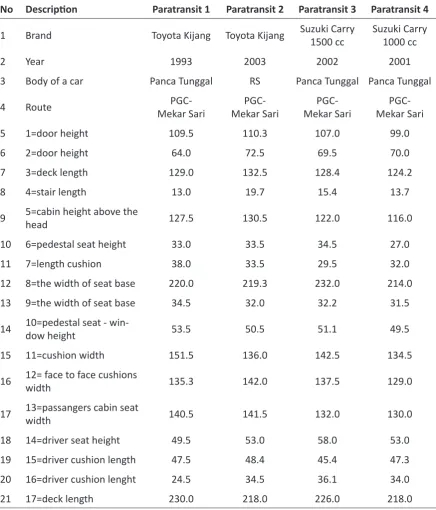Introduction
Ergonomics is needed in every activities of life in order to provide convenience, get easiness, support low cost
efficacy, avoid accidents, create good performance, boost efficiency and
effectiveness. Otherwise, life will be much more complicated.
Convenience, welfare, and perfor-mance are easily affected by the facilities designed compatibly human bodies; their dimensions, normal body movement, muscle power, speed, temperature, sound, etc. One of the facilities is the trans-portationation used by the people.
To design a compatible facilities including paratransit, we need a discipline called Ergonomics / Human Engineering. If people apply it when they design the paratransit, they will consider some factors which are the size and shape of human body, muscle power, fast response, light, eye-sight, ideal working temperature, noise, factors caused tiredness, and pollution effect. After considering these factors and applying the Ergonomics to the facilities they design, they will feel convenient,
pleasure, satisfied, healthy, have high productivity, work effectively, efficiently
and at minimum risk.
To test whether the paratransit route PGC – Mekar Sari is ergonomics or not, researchers tried to collect the data through library research, take samples from mini ergonomics’ lab, analyze statistically, give
the data of body measurement, take field
sample, and study the case.
Library research is needed to have a better understanding of what ergonomics is and how to apply it by salient reading through books, magazines, newspapers, and sites about Ergonomics, Human Engineering, and Designs.
Results and Discussion
The findings have been identified in
the mini ergonomics’ lab, where there are some steps to be applied. First, conducting
the primary study to find out the dimensions
of interior from the paratransit which will be studied. In this case, it means the
Paratransit Ergonomics
Hendro Kuntohadi Yosi Pahala Aang Gunawan
STMT Trisakti STMT Trisakti STMT Trisakti
stmt@indosat.net.id including in designing the paratransit. Through library research, mini lab-testing, and
field study, we could find out how ergonomics our paratransit is, in this case paratransit
route Pusat Grosir Cililitan (PGC) Mekar Sari. Based on the study, it is revealed that the ergonomics value which should be applied cannot be achieved due to overloaded passen-gers of the transportation that caused inconvenience.
paratransit route PGC – Mekar Sari. Second, deciding the dimensions of human body to be measured. Then, designing and measuring the compatibility of the human body and the facilities; for example the seats in the vehicles.
The samples used in this study are taken randomly from passengers of ‘angkot’ (e.g Mikrolet, KWK) route PGC-Mekar Sari, respondents are based on various gender, ethnicity, age, and social status.
After collecting the data and filling in the
table, the researchers analyze the data statistically. First, we made the histogram and the normal distribution calculation. Then, we made the table based on percentile calculation (5 %, 50 %, and 95 %).
In designing the ergonomics’ seats, we have to decide the measurement of the seats and the interior of the transportation discipline or not related to the interior and facilities dimensions. We analyze the dimensions, shapes, and the ergonomics’ passengers’ capacity. As stated before, researchers pick out to study the paratransit route PGC – Mekar Sari for this case.
A. Ergonomics
The International Ergonomics
Asso-ciation defines ergonomics or human factors
as follows; “Ergonomics (or human factors)
is the scientific discipline concerned with
the understanding of interactions among humans and other elements of a system, rules. The term is used in Europe and other countries with the same or different names. For example, in Scandinavia they use the word Biotechnology that resembles the same meaning. In USA and other countries, they popularize the word Human Factors that related to Ergonomics. While in the military services in USA, the term Human Engineering is more popular and the psychologists call it Psychology Engi-neering.
According to William S. Marras from Ohio State University, Human Factors focused on people and their interaction with products, utilities, facilities, procedures, and environment that are used at work and daily activities.
The purposes of Human Factors are: To enhance the effectiveness and 1.
efficiency of daily activities and at work.
It also includes enhancing the users’ satisfaction and productivity and of course minimizing the errors.
To enhance the expected human value 2.
such as enhancing the safety and convenience, the work satisfaction and quality of life and also minimizing the tiredness and stress.
Human factors and ergonomics are
concerned with the ‘fit’ between the user,
equipment, and their environments. It takes account of the user’s capabilities and limitations in seeking to ensure that tasks, functions, information, and the environment suit each user.
Chapanis (1985) defines Human Factors as a method to find and apply
characteristic to design tools, systems,
tasks, activities, productive field, safety,
convenience, and effectiveness.
Ergonomics, physically, is concerned with human body dimensions, temperature, noise, pollution, lights, colours effect, environment, human interaction with machines or tool, etc (see Table 1).
One of the sub-discipline of Ergonomics is Anthropometry. In Greek, it means measurement of the individual human. Today, it plays an important role in industrial design, clothing design, ergonomics, and architecture where statistical data about the distribution of body dimensions in the population are used to optimize products.
In this study, the measurement of
human body dimensions covers sufficient samples to fulfill the statistical data. This statistic data contains sufficiently normal
data that represents a population. The data needed must cover these categories; male, female, age, origin, social status or level, and others.
There are two different size of human body; big (maximum) and small (minimum).
In the field of Ergonomics, only 95 % of
human body dimensions that can be used to design and implement the tools while the rest 5 % will have its own problem.
The usual measurement of human body dimensions are:
1. 5 % percentile is called minimum 2. 50 % percentile is considered average 3. 95 % percentile is defined maximum
Each percentile is used and designed compatibly with the tools and environment (see Figure 1 & 2). Using the histogram has given a chance to eliminate useless data such as outliers, maximum and minimum. To decide which percentile is used, the tools dimensions must be considered. As an example, the chair leg, the width of chair per person, must be considered before taking the 95 % percentile from men (see Table 2). For 5 % percentile, the researcher took the data from female length of arms in reaching the holder in Trans Jakarta (see Table 3). For 5 % to 95 % percentile, the researcher took an example from the adjusting seats in the car or from the adjusting head rest in a car.
C. Sample Collection in the Field
By measuring the interior dimensi-ons of the paratransit and measuring the seats, the researcher took the primary data from 4 paratransits route PGC – Mekar Sari as the case study.
After doing the research of some paratransits route PGC – Mekar Sari, there
are some results can be concluded. The first
one is paratransit type Toyota Kijang, produced 1993 (Panca Tunggal). The width of the seats is 220 cm while male length of shoulder (95 % percentile) is 49.16 cm. In this case, the ergonomics seats availability is 4.5 persons. This data is calculated; 220 / 49.16 = 4.48 (see Figure 3 & 4).
that ergonomically only available for 4 persons (151.5 / 49.16 = 3.08) beyond the reality (see Table 4).
The seat next to the driver is available for only 2 passengers. This is due to the calculation 140.5 cm (the width of the seat) divided by 49.16 (male shoulder width). Unfortunately, the drivers often force 3 persons to sit next to him (see Figure 6).
The second analysis is applied to Suzuki Carry 1000 cc, 2001 (Panca
Tunggal). The first analysis is for the long
seat. It has width 214 while male shoulder width is 49.16. It means after dividing the researcher get the availability 4 persons to sit there. As usual, if the driver forces 5 to 6 people to sit there, it will be much more uncomfortable. The second analysis is the door height. Male height (after bowing with 95 % percentile) is 124.14. It means the door height (only 99 cm) is really not
sufficient for passengers. The door height
should be 124.14 cm. This number comes from 124.14 – 99 = 25.14. The third one is taken from the width of seat next to the driver. The width is 130 cm while the male shoulder is 49.16 cm. If we devide this number, we’ll get only 2 persons available to sit there. In some cases, drivers force 3 persons to sit next to him.
The last type of paratransit is Toyota Kijang 2003 (RS). From the ergonomics analysis, the researchers get some results. Measuring the range of the long seat to the smaller seat is 142 cm, this calculation is needed to know the suitable space for passengers sitting face to face. The calculation is (64.04 + 30.40) x 2 = 188.88. It means there will be high inconveniences due to the crossing feet of the passengers one another. They need space 64.04 x 2 = 128.08 cm. There is of course space for
knees but still it is difficult for them to get
in and get out (see Figure 7).
Conclusion
Based on the case study that has been explained above, it can be concluded that our paratransit esp. route PGC – Mekar Sari still needs to be improved to create ergonomics paratransit that support passengers conveniences. It can be done when the government regulation also work hand in hand with the ergonomics discipline in designing paratransit. Otherwise, the discipline cannot be applied due to the naughty drivers who love to force unreasonable number of passengers into their car.
References
Doane, David P and Seward, Lori E. 2008. Essential Statistics in Business and Economics. 1st Edition. Boston, USA: Mc Graw Hill.
[IEA] International Ergonomics
Association. 2000. Triennial Report. Santa Monica CA: IEA Press.
Sanders, Mark S and McCormick, Ernest J. 1993. Human Factors in Engineering and Design. Seventh Edition. New York, USA: McGraw-Hill.
Supranto, J. 2001. Statistik, Teori dan Aplikasi. Jilid 1 & 2. Edisi 6. Jakarta: Erlangga
Figure 1 Normal Distribution with 5 %, 50 %, and 95 % Percentile
Source : Ergonomic, Image, Google.com
Figure 2 Parts of Human Body Measured to Design Ergonomics Paratransit
Figure 3 A Seat Standard Size in Paratransit for One Person
8
1
2
3
4
5
6 7
9
1
0
11 12
17
Figure 4 Paratransit Interior Dimensions
SANDARAN KEPALA
13
1
4
15
1
6
Lantai
Figure 5 Seats for Drivers and Passangers
Floor
Figure 6 Paratransit Interior Dimensions of Toyota Kijang
No Parts of The Body
1 height 153.12 166.4 179.44
2 arm span height 161.74 176.2 188.46
3 weight 20.00 26.00 35.08
4 foot weight 8.72 10.50 13.02
5 height when bowing 104.18 115.90 137.94
6 head to toe 76.46 82.40 89.98
7 shoulder height 50.52 57.00 62.90
8 seat length 36.40 42.93 49.06
9 seat height 38.50 42.40 47.22
10 leg length 23.44 28.50 30.40
11 width 10.46 13.30 17.20
12 hip to knee 47.52 56.00 64.04
13 arm span 54.76 63.40 69.54
14 head width 15.16 17.00 18.58
15 5 fingers width 9.32 10.80 13.000
16 4 fingers width 6.6 8.20 10.00
17 hip width 29.64 33.20 40.30
18 shoulder width 39.94 44.20 49.16
Table 2 Male Body Dimensions, n = 70
No Parts of The Body Percentile 5%
(Minimum)
1 height 148.70 158.30 167.17
2 arm span height 158.17 167.55 186.29
3 weight 19.82 24.05 32.96
4 foot weight 8.08 9.55 11.67
5 height when bowing 106.27 114.25 124.14
6 head to toe 74.39 80.25 85.39
7 shoulder height 43.86 54.05 61.71
8 seat length 29.76 44.3 49.75
9 seat height 37.32 41.40 50.03
10 leg length 24.00 25.75 29.88
11 width 9.71 11.55 16.00
12 hip to knee 49.58 53.85 62.60
13 arm span 53.47 58.95 69.63
14 head width 12.98 16.55 19.05
15 5 fingers width 9.00 10.15 11.73
16 4 fingers width 6.39 8.00 9.73
17 hip width 29.35 32.85 39.4
18 shoulder width 36.82 43 41.62
No Description Paratransit 1 Paratransit 2 Paratransit 3 Paratransit 4
1 Brand Toyota Kijang Toyota Kijang Suzuki Carry
1500 cc
Suzuki Carry 1000 cc
2 Year 1993 2003 2002 2001
3 Body of a car Panca Tunggal RS Panca Tunggal Panca Tunggal
4 Route
PGC-Mekar Sari
PGC-Mekar Sari
PGC-Mekar Sari
PGC-Mekar Sari
5 1=door height 109.5 110.3 107.0 99.0
6 2=door height 64.0 72.5 69.5 70.0
7 3=deck length 129.0 132.5 128.4 124.2
8 4=stair length 13.0 19.7 15.4 13.7
9 5=cabin height above the
head 127.5 130.5 122.0 116.0
10 6=pedestal seat height 33.0 33.5 34.5 27.0
11 7=length cushion 38.0 33.5 29.5 32.0
12 8=the width of seat base 220.0 219.3 232.0 214.0
13 9=the width of seat base 34.5 32.0 32.2 31.5
14 10=pedestal seat -
win-dow height 53.5 50.5 51.1 49.5
15 11=cushion width 151.5 136.0 142.5 134.5
16 12= face to face cushions
width 135.3 142.0 137.5 129.0
17 13=passangers cabin seat
width 140.5 141.5 132.0 130.0
18 14=driver seat height 49.5 53.0 58.0 53.0
19 15=driver cushion length 47.5 48.4 45.4 47.3
20 16=driver cushion lenght 24.5 34.5 36.1 34.0
21 17=deck length 230.0 218.0 226.0 218.0
